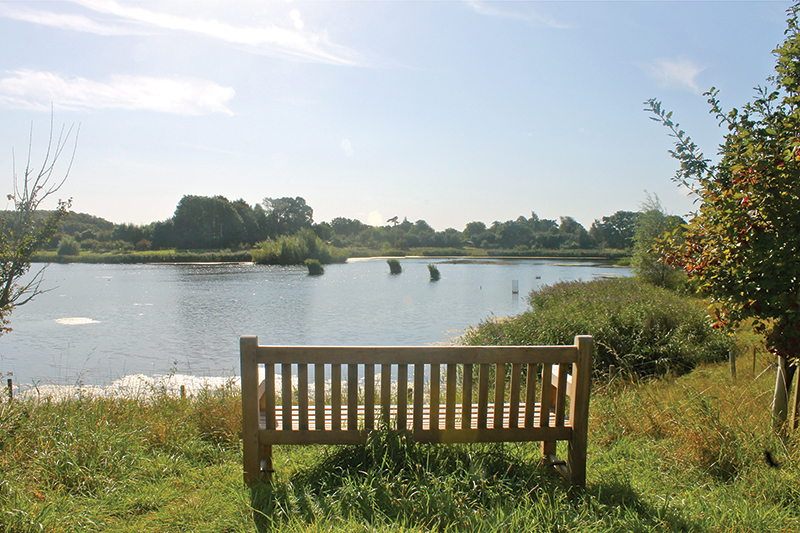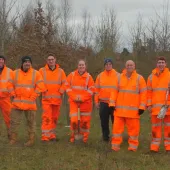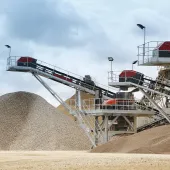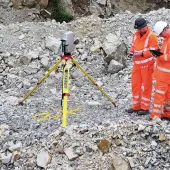Quarrying’s Biodiversity Boost: A Story to be Told

First published in the May 2014 issue of Quarry Management
The Mineral Products Association’s 2013 Restoration & Biodiversity Awards
An area of priority habitats the equivalent of at least five Richmond Parks has already been created on minerals sites, with this set to double as currently worked sites are restored. This significant contribution to nature conservation and biodiversity was evidenced at the Mineral Products Association’s Restoration & Biodiversity Awards, which took place on 16 October 2013 at the Royal Society in London.
Nigel Jackson, chief executive of the Mineral Products Association (MPA), said: ‘This fact might seem surprising to many people who do not associate our industry with biodiversity enhancement, but in fact the quarrying sector is very active on this front and uniquely placed to benefit nature.
‘Once again our members have demonstrated how much good work they are doing to achieve high-quality restoration and to protect and enhance biodiversity throughout the country. Their innovations and partnerships are delivering progress, priority habitats and assets locally and for the UK. The industry’s legacy is growing and the potential is being realized, and now we hope that it is being recognized.’
RSPB research indicates that mineral sites could meet 100% of the targets for nine out of 11 priority habitats previously identified in the UK Biodiversity Action Plan (BAP). The quarrying industry's biodiversity contribution, a unique differentiator and defining characteristic of the sector, was praised by DEFRA Minister Lord de Mauley, who said: ‘These awards demonstrate the close relationship the MPA and its members have built with wildlife organizations to enhance and protect biodiversity, and deliver a lasting legacy for wildlife.’
Last year’s event celebrated the excellent work MPA member companies are undertaking, showcasing some of the best examples of quarry restoration and wildlife conservation anywhere in Europe. Several speakers from nature conservation groups highlighted the value of working in partnership with the quarrying industry. They included: Stephanie Hilborne OBE, chief executive of The Wildlife Trusts; Paul Lambert, executive director of Natural England; Gill Perkins, conservation manager with the Bumblebee Conservation Trust; and Jeremy Biggs, director of the Freshwater Habitats Trust.
Stephanie Hilborne said: ‘The Wildlife Trusts recognize that MPA members take their responsibility for nature very seriously and have an impressive track record of investing in wildlife habitats. Few sectors have so many staff who are so genuinely committed to the natural environment, and few companies can rival the strength of some of the partnerships we have built between minerals and wildlife charities. Our complementary skills and expertise allow us to work in close partnership to generate real benefits for the environment and society.
‘Now that the wider corporate sector is beginning to recognize the value of natural capital, the MPA and its members have an opportunity and a responsibility to lead the way. More businesses need to learn how to go about investing in nature’s recovery and the creation of ‘Living Landscapes’, involving local communities all the way along. We need your industry’s continued support and commitment, and as other businesses learn the ropes we need the minerals sector to be pushing the boundaries further and building even more profound partnerships with organizations such as The Wildlife Trusts.
‘Given the pioneering role the minerals sector has played, it seems appropriate to use the MPA’s Restoration & Biodiversity Awards to thank members for their genuine and continued commitment to wildlife.’
Paul Lambert, executive director of Natural England, said: ‘The MPA’s commitment to restoring biodiversity and engaging with local communities is a shining example of what industry can do for people and for wildlife. The Association and its members are uniquely placed to deliver for nature through their management and restoration of sites. The MPA is also uniquely placed to share its innovation and commitment with industry more widely. We look forward to continuing our partnership with the Association to help business to recognize the value of the natural environment.’
The Evidence - MPA Restoration Awards
The MPA’s long-standing Restoration Awards have been recognizing exceptional practice for more than 40 years and the 2013 winner of the top accolade – the Cooper-Heyman Cup – was Lafarge Tarmac’s Ibsley Quarry, in Hampshire. This superb site for nature has been restored to a mix of open-water conservation lakes, wetland and grassland. It has already won ➤ an award from the British Trust for Ornithology for attracting birds, and is particularly significant because of the way it fits into the wider strategies for the area in terms of landscape, ecology, biodiversity, access and restoration.
Hanson UK’s Pateley Bridge Quarry, in North Yorkshire, in partnership with Nidderdale Visual Arts, Golder Associates, Nidderdale Plus and Harrogate Borough Council, was highly commended in the Restoration Awards and also won an MPA Special Award. Hanson UK and Nidderdale Visual Arts commissioned the huge Coldstones Cut sculpture on a vast 92ha screening mound, which was created by moving in excess of 2 million cubic metres of soil. The company also relocated large areas of high-value grassland and created a series of ponds and a marsh area for amphibians. The restoration currently attracts more than 30 species of nesting birds.
Lafarge Tarmac’s Threshfield Quarry, in the Yorkshire Dales National Park, was also highly commended. Here, the company has planted new trees, created three large ponds, rebuilt dry stone walls and created footpaths – much of the rest of the regeneration will happen naturally over time. Old lime kilns and other buildings have been retained in an area of the quarry that is being leased to a community group for arts, heritage and business uses. The vision is of a place that becomes a tourist venue within the national park.
The Evidence - MPA Biodiversity Awards
For the first time last year, the MPA’s Biodiversity Awards had three categories: Landscape-Scale Restoration (in association with Natural England); Innovation; and Individual Contribution.
The winner of the Landscape-Scale Restoration category was the Upper Nene Valley Gravel Pits, in Northamptonshire, entered by Hanson UK. With considerable help from Hanson UK’s network of operational and restored quarries in the area, here a 16-mile long string of carefully managed wetlands has allowed the creation of one of Europe’s newest Special Protection Areas for vulnerable bird species.
The runner-up of the Landscape-Scale Restoration category was Bayston Hill Quarry, in Shropshire, which was entered by Lafarge Tarmac and Shropshire County Council. Lafarge Tarmac have created a large new screening bank which also incorporates 20ha of priority habitat on what was previously farmland. After only a short time in existence the bank is making a major contribution to Shropshire’s biodiversity targets.
The winner of the Innovation category was Ardley North Quarry, in Oxfordshire, which was entered by Smiths & Sons (Bletchington) Ltd with their landscape consultants ESP Ltd. They used Pond Conservation’s ‘Aggregates Pond Creation Toolkit’ to adapt their restoration scheme in 2009. This included creating a series of overflowing ponds which vary in profile and not only attenuate surface water and reduce erosion, but also enhance biodiversity. The ponds offer many aquatic and marginal habitats for diverse species. Importantly, the ponds feed into a wider aquatic network through a specially created rock weir cut into the limestone ridge of a geological SSSI, with the permission of Natural England.
The runner-up in the Innovation category was Hanson UK’s Whiteball Quarry, in Somerset. One of Whiteball Quarry’s ponds was developed as an ‘ark site’ habitat for native white-clawed crayfish, away from the threat of signal crayfish. Surveys of the area revealed five species of amphibians, including great crested newts. After Buglife had submitted a paper to Natural England explaining that the introduction of white-clawed crayfish to the pond would not have a significant effect on the newts, the crayfish translocation license was granted. Sixty tonnes of rock were placed to provide holes for crayfish refuge and breeding before the crustaceans were released into the pond.
The Butterfield Trophy for Individual Contribution to biodiversity was won by Phil Harding, farms and restoration manager with the Brett Group. His individual efforts have helped to deliver a long list of first-class restoration and biodiversity projects, and a continuous stream of awards. It is in no small part due to Mr Harding that Brett have won the MPA’s prestigious Cooper-Heyman Cup for top-class restoration no fewer than five times during his time with the company.
Almost 200 delegates attended the 2013 awards event, including representatives from more than 50 environmental and other stakeholder organizations, along with those from industry, government departments, academia and local authorities. Sybil Ruscoe, an experienced journalist most recently associated with BBC Radio 4’s ‘Farming Today’ programme, expertly hosted the proceedings, with live presentations being complemented by on-screen video footage of the winning sites.
- Subscribe to Quarry Management, the monthly journal for the mineral products industry, to read articles before they appear on Agg-Net








